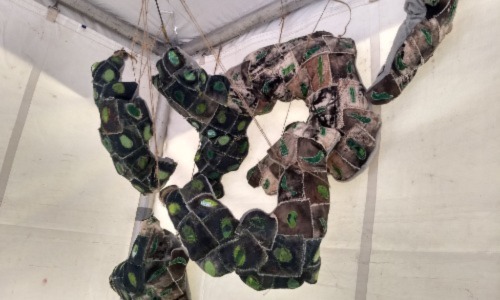What's the Quorum?
Posted on May 23, 2023 by Dr Jennifer Rattray
Dr Jennifer Rattray takes us behind the scenes of her latest publication 'The dynamic response of quorum sensing to density is robust to signal supplementation and individual signal synthase knockouts' published in Microbiology.
Fluorescence microscopy image of individual Pseudomonas aeruginosa cells tagged with a green fluorescent marker of virulence activity.
My name is Dr Jennifer Rattray, I'm a postdoctoral fellow in Global Chemical and Biological Security at Sandia National Laboratories in the United States. This work was done during my time as a National Science Foundation Graduate Research Fellow in Dr. Sam Brown’s lab at the Georgia Institute of Technology. As a microbial and evolutionary ecologist interested in emerging biological threats, I take a top-down approach to understand disease-causing agents. This means that I study complex systems as a whole and work inwards - like starting a puzzle by building the outer edges first.
Our understanding of how bacterial pathogens cause disease is ever evolving. As of now, we know that the ecological bacterial component of an infection is a complex mix of community dynamics, spatio-temporal dynamics, and behavioral dynamics, along with constant evolutionary feedback dynamics. This work focuses on the behavioral component. Thanks to a lot of hard work by molecular biologists and chemists, we know that group-dependent pathogenesis in bacteria can be controlled on the molecular level by a form of cell‐cell communication mediated by diffusible signal molecules called quorum sensing (QS). Each individual produces and responds to these diffusible signaling molecules, inferring properties of their environment and modulating the regulation of hundreds of downstream genes in response. Traditionally, QS dynamics are studied in reference to population density, hence the legal ‘quorum’ analogy. We studied QS in the context of Pseudomonas aeruginosa, a laboratory-tractable gram-negative bacterium capable of causing severe chronic illness and a major cause of acute hospital-acquired infections that represents one of the most intensely studied pathogen model systems for QS.
As microbial ecologists, to understand a system we like to first observe the system and then test the extremes to push the system to a ‘breaking’ point so that we can identify the dynamic range of behavior. A growing body of literature highlights that QS can produce more nuanced, graded responses to environmental variation, implying there is no simple threshold ‘quorum’ on either the single cell or population scale. In this paper we control the quantity and type of chemical signal and observe the population-level response by tracking expression of the virulence factor, elastase. Looking at QS dynamics across discretely controlled environments rapidly increases the amount of data required to make any conclusions, which complicates analysis. To manage this, we introduce the use of “reaction norms”, a historical concept in ecology, to reduce the dimensionality of this data and highlight its power to make broad conclusions.
One result that stuck out for us is the robustness of this behavior to multi-signal input. The two acyl-homoserine lactone (AHL) signals we used are two of the major QS signals studied by the field. Addition of both of these AHL signals to either the WT or the double AHL synthase deletion strain did not negate the ability to sense density, even those these were density-independent concentrations. The only scenario that reproducibly reduces the ability to sense density was when we flooded WT populations with not only both AHL signals, but also the lesser-studied Pseudomonas Quinolone Signal (PQS).

The robustness of this ability of P. aeruginosa to use QS to sense their density environment is likely a result of the interconnectedness of the multiple signal-receptor systems. Many researchers in the field are recognizing this complexity and our results call into question the use of AHL synthase deletions strains as a null model of this behavior, at least when manipulating the system. The use of reaction norms to reduce the complexity of this data also brought about a serendipitous result from this work- a potential link between divergent QS activity and antimicrobial resistance. P. aeruginosa naturally has high amounts of antimicrobial resistance and is, in general, a stubborn pathogen when it comes to treatment. Since the study, we’ve seen that different lab strains of P. aeruginosa, caused by natural microevolution in laboratory research, have reaction norms that induce at different densities indicating there is a different baseline sensitivity for sensing their environment. Efflux pump regulation, which seems to be a key difference between these lab strains, traditionally mediates antimicrobial resistance but also may impact the intracellular and extracellular concentrations of QS signals and therefore the ability of QS to act as a collective mediator of pathogenesis. A comparative study using reaction norms across laboratory strains could be an exciting intersection between signal mediated pathogenesis, antimicrobial resistance, and collective behavior.

